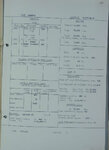Shortround6
Lieutenant General
Manual for the MK V says max dive angle for using the 500lb bomb is 55 degrees.
You are up against the weird British system of holding the bomb bay doors closed with elastic cords and depending on the bomb's weight to overcome the cord tension and push the doors open.
Perhaps not a deal breaker in itself but unless you really change the bomb bay and the doors you are limited to a pair of 500lb bombs which are not exactly either ship or bridge killers. Not like a JU 87 or 88 with 1100lb bombs or larger.
Bolt the doors closed and use external bomb carrier/s?
British could have gotten a lot more mileage out of the Blenheim if they used it for some of the roles it was more suited for, The MK IV was intended as a maritime recon version, Pushed aside by the Botha and Beaufort. Maybe not as good as they were in theory (no 4th creman) but better than the Anson.
If you are going to build a fighter Blenheim then build a fighter Blenheim, give it a gun pack that doesn't look like it was made by home handyman out of plywood using a hand held circular saw. ( the ability to tip down for loading and servicing the guns was rather neat but come on, they built hundreds of these things and never improved the aerodynamics)
Get rid of the turret on the fighters, clip wings? fit constant speed props? improve fit and finish?
You might have been able to add 15-20mph to the fighter versions and while still in trouble against 109s or 110s the bombers would have a much harder time getting away from them.
Stick 2-4 guns in the nose of the night fighters in addition to a streamline belly pack?
add 1-3 guns in the wing?
Get the Blenheim fighter up to a 6-8 gun fighter instead of a 5 gun fighter?
You are up against the weird British system of holding the bomb bay doors closed with elastic cords and depending on the bomb's weight to overcome the cord tension and push the doors open.
Perhaps not a deal breaker in itself but unless you really change the bomb bay and the doors you are limited to a pair of 500lb bombs which are not exactly either ship or bridge killers. Not like a JU 87 or 88 with 1100lb bombs or larger.
Bolt the doors closed and use external bomb carrier/s?
British could have gotten a lot more mileage out of the Blenheim if they used it for some of the roles it was more suited for, The MK IV was intended as a maritime recon version, Pushed aside by the Botha and Beaufort. Maybe not as good as they were in theory (no 4th creman) but better than the Anson.
If you are going to build a fighter Blenheim then build a fighter Blenheim, give it a gun pack that doesn't look like it was made by home handyman out of plywood using a hand held circular saw. ( the ability to tip down for loading and servicing the guns was rather neat but come on, they built hundreds of these things and never improved the aerodynamics)
Get rid of the turret on the fighters, clip wings? fit constant speed props? improve fit and finish?
You might have been able to add 15-20mph to the fighter versions and while still in trouble against 109s or 110s the bombers would have a much harder time getting away from them.
Stick 2-4 guns in the nose of the night fighters in addition to a streamline belly pack?
add 1-3 guns in the wing?
Get the Blenheim fighter up to a 6-8 gun fighter instead of a 5 gun fighter?

